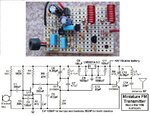boylesg
Advanced Member level 4
- Joined
- Jul 15, 2012
- Messages
- 1,023
- Helped
- 5
- Reputation
- 10
- Reaction score
- 6
- Trophy points
- 1,318
- Location
- Epping, Victoria, Australia
- Activity points
- 11,697
I have got this project working brilliantly with an FM radio - impressed.
View attachment 146201
But I have run into a problem and learned something new about electret microphones in the process.
I bought a mono shirt collar microphone to use with it in place of the supplied electret that is normally soldered straight on to the PCB - more convenient for practical use in the scenario I have in mind.
But the audio coming through on the radio is very weak when I use the chorded microphone, but very strong if I use the supplied electret plugged straight onto the headers I have put on the PCB.
I assume that to much power is being lost over the long lead since the amount of current with a 47k resistor (that powers the electret) is tiny anyway.
So would it be as simple as replacing that 47k resistor with a 10k or less resistor?
Or is it more complicated than this?
View attachment 146201
But I have run into a problem and learned something new about electret microphones in the process.
I bought a mono shirt collar microphone to use with it in place of the supplied electret that is normally soldered straight on to the PCB - more convenient for practical use in the scenario I have in mind.
But the audio coming through on the radio is very weak when I use the chorded microphone, but very strong if I use the supplied electret plugged straight onto the headers I have put on the PCB.
I assume that to much power is being lost over the long lead since the amount of current with a 47k resistor (that powers the electret) is tiny anyway.
So would it be as simple as replacing that 47k resistor with a 10k or less resistor?
Or is it more complicated than this?

